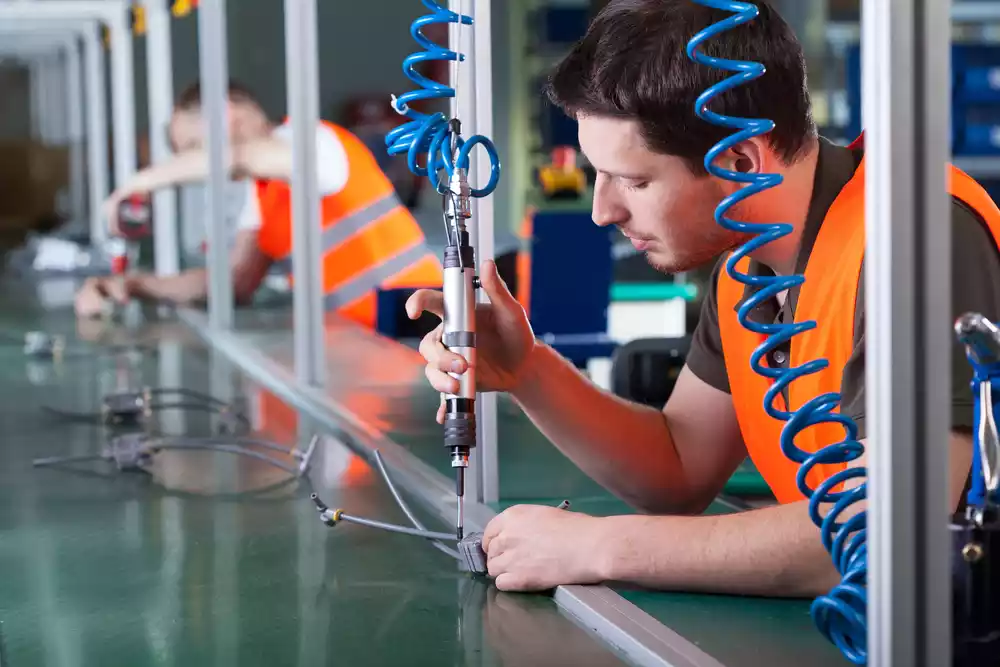
The process of overmolding plastic on metal is an advanced manufacturing technique that allows for the fusion of metallic and polymeric components to create more durable, functional, and aesthetic parts. It is an engineering solution that is redefining sectors from automotive to consumer electronics, and it is the type of high-precision challenge where IMA’s experience makes the difference as the most capable partner to execute this complex process with maximum quality and efficiency.
What is overmolding plastic on metal?
Overmolding plastic on metal is a two-step injection molding process. It involves taking a pre-fabricated metallic substrate (the insert) and placing it inside an injection mold. Subsequently, thermoplastic or elastomer material (the overmold) is injected onto and around that substrate.
The result is a monolithic, composite part where the metal and plastic are joined mechanically or chemically, without the need for subsequent adhesives or assembly. This process answers the question “Can you overmold metal?”, with the answer being a resounding yes, and it is the basis for everyday products like power tools, high-end toothbrush handles, and hermetically sealed components.
Precision component manufacturing companies, like IMA, use this method to guarantee maximum durability and functionality in parts that require both the structural strength of the metal and the soft touch or insulation properties of the plastic.
Advantages and disadvantages of overmolding types
While overmolding plastic on metal is the primary focus, it is useful to compare it with its more common alternative, plastic-on-plastic overmolding (generally a rigid plastic as the substrate and a thermoplastic elastomer (TPE) as the overmold).
| Aspect | Overmolding plastic on metal | Overmolding plastic on plastic |
| Structural Integrity | Superior strength and rigidity: The metal provides the core resistance, ideal for parts subjected to high mechanical stresses. | Lower Strength: The final part has less strength and rigidity compared to overmolding plastic on metal. |
| Functionality | Hermetic sealing and insulation: Perfect for sealing internal electronic components or creating durable anti-slip handles. | Greater design flexibility: Allows for the creation of soft grip areas or flexible seals over a plastic component. |
| Durability | Temperature resistance: Metal handles heat better than plastic, extending the useful life of the part. | Material Compatibility: The two plastics must be chemically compatible to achieve a good bond. |
| Disadvantages | High Tooling Cost and Complex Adhesion. | More economical and faster production cycles. |
Overmolding as a business benefit point
Adopting overmolding technology offers strategic advantages that go beyond product design, directly impacting a company’s bottom line:
- Reduced assembly costs: By creating a composite part in a single production cycle, the costs of labor, adhesives, screws, and fasteners required to assemble the metal and plastic separately are eliminated.
- Improved perceived quality: An overmolded part feels premium, with a perfect fit and finish. This elevates brand value and can justify a higher selling price.
- Part consolidation: Overmolding allows combining the function of several parts into one, reducing inventory complexity, the Bill of Materials (BOM), and potential failure points.
- Product differentiation: The ability to integrate overmolding plastic on metal into handles, housings, or connectors provides a unique advantage that competitors using traditional assembly methods cannot easily replicate.

Machinery used for overmolding
The key to overmolding lies in the plastic injection molding equipment.
For plastic molding: Conventional injection machines are used. The main difference is in the mold. For overmolding, an insert mold is employed, which has specific cavities and mechanisms to hold the metallic part while the plastic is injected.
For the metallic component (the Insert): Metallic inserts are typically manufactured using processes such as CNC machining (Computer Numerical Control), die casting, or, in the case of sheets, precision stamping.
The process requires high-precision automation (such as pick-and-place robots) to ensure that the metallic insert is perfectly positioned in the mold before clamping and injection.
Which type of overmolding is best for your company?
The answer to “Which one is best for any company?” is that it depends entirely on your product’s performance requirements and budget.
Choose overmolding plastic on metal if your product requires maximum mechanical strength, rigidity, excellent heat dissipation, or if you need a conductive component inside a sealed housing (typical for sensors or medical devices).
Choose overmolding plastic on plastic if your primary goal is ergonomics, soft grip, or creating a simple environmental seal over an already structurally sound base, and you are looking to minimize manufacturing cost.
Ultimately, the success of your overmolding project hinges on expert planning and execution.
Partnering with a specialized manufacturer like IMA allows you to thoroughly analyze your part requirements, from the strategic selection of materials (plastics, metals, and bonding agents) to the optimization of tool design. This approach ensures that the chosen overmolding technology not only guarantees uncompromised quality but also maximizes your return on investment (ROI).
If your next project demands precision engineering and unparalleled manufacturing expertise, our facilities are ready to assist you with your next cable assembly in Arizona.
